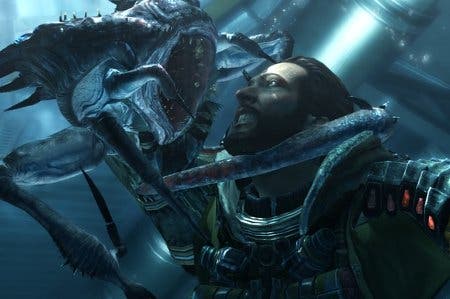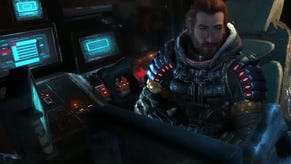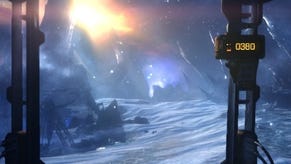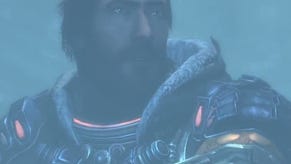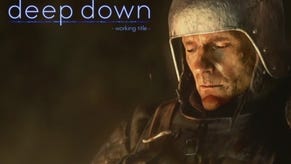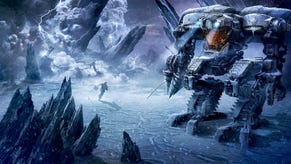Lost Planet 3 Preview: Surviving the Pressure
Can the Legendary developer do Capcom's series justice?
"This is the closest that the franchise has come to my original vision," says Lost Planet's creator Kenji Oguro seconds before we first lay eyes on the surprise third entry in Capcom's extreme conditions action series. That may well be the case, but Lost Planet has had to travel some 5700 miles from where it was first conceived to get there.
Once the lights come up after an impressive and generous hands-off demo of Lost Planet 3, there's one image that lingers long after that of the stomping mechs facing off against giant enemy crabs against the cold, blue backdrop.
It's that logo in the lower-right of the screen as the credits fade in, revealing exactly who is behind this expansion of a series that started at the dawn of this generation of consoles, and a series that looks to be sending it off in no small amount of style. Spark Unlimited, it says - and anyone who can remember as far back as 2008 will forever associate the Californian developer with two of the most turgid games to grace this generation: Turning Point and Legendary: The Box.
It's no wonder that Capcom's keen on keeping that significant part of Lost Planet 3's make-up away from the spotlight; the Osaka-based outfit's made a habit of partnering with Western developers in recent years, with varying degrees of success.

There was Grin's dalliance with Bionic Commando, a pairing so flawed it killed off a classic IP and sowed the seeds for the developer's own demise. Most recently - and, perhaps, most painfully - there's been Slant Six's mishandling of Operation Raccoon City, an ill-fated blend of a franchise that's lost its direction with a developer that's never really had any of its own.
But there are the happier stories, too. It's yet to surface for air, but Ninja Theory's take on Devil May Cry looks it'll have the last laugh, and it could well laugh loudest - with the business end of the game finally coming into focus, Capcom seems to have married the strength of the Cambridge studio's vision with the race-tuned combat that made the series' name. And then there's Blue Castle's effortless handling of the Dead Rising sequel, a game that extracted the essence of the original and made it purer and that much easier to swallow.
Capcom, of course, is hoping that Lost Planet 3 will fall into the latter category - and, right now, there's every chance that it will. It's a collaborative project, with Spark working from a brief provided from Oguro. "We've been working together on it from day one," says producer Andrew Szymanski. "We've been working together with Spark to make sure it feels like Lost Planet, and it feels like a Capcom game."
It looks like a Capcom game too, graced with production values alien to Spark's prior efforts and imbued with a certain videogameness that's very much the mark of the Japanese outfit. Spark's shied away from using Capcom's own MT Framework engine, leaning instead on its knowledge of Unreal 3, and the results are attractive to say the least.
In the soft blues of its cold neon and even colder frozen landscapes there's a keen eye shown for seventies sci-fi cinema, and it's a world that's fittingly bleak and believable. It's an extension of Capcom's existing ideas - and is, indeed, a prequel to the first Lost Planet - but it's easy to believe Oguro when he says the results are as faithful to his original vision as any other game has been.
E.D.N III's the backdrop, and mercenary Jim's the star of the single-player campaign (multiplayer returns, Capcom assures, though unlike Lost Planet 2 it won't be the focus - and details on that side of the game remain under wraps for now). Jim comes across like the gentler, more loving brother of StarCraft's Jim Raynor - he has a wife and kid waiting at home, and he's working on this cold, alien world to supply for them.
Cut-scenes are plentiful but, in something of a rarity, seem well directed, displaying a pace and charm that escapes most other examples in the medium. It's a character that spreads across the rest of Lost Planet 3 - as the action is handed over to the player and Jim explores a cavernous workshop that acts as a mission hub of sorts, he comes across a swathe of NPCs, all drawn with gentle strokes.
As Jim enters his mech - one of Lost Planet's trademark features - Spark's first tinkering with the formula becomes clear. Once on board, the camera switches to first-person, the view framed by the steel and readouts of the cockpit. The intention behind the switch is clear; there's a heightened sense of physicality to the ride, a slow clump and weave introduced as the mech moves slowly across the loading bay.
Once outside, Lost Planet 3 settles into a more familiar rhythm. It's as much a case of the player against the environment as it is the player against the hostile Akrid. And, for all of its latent hostility, what a wonderful world it is; blues and whites stretch out into the distance in strange and often beautiful forms, while a pack of Akrid dogs pace across the ice. In the distance, an electrical storm brews - a foreshadowing of another of Spark's welcome additions to the series.
A temperature gauge is a constant presence when piloting the mech, and it's something that has to be constantly measured - if it dips too low, Jim has to leave the mech to chip away at the surrounding ice with his rifle. It's a point that's proven to excess when a storm comes in hard and fast, entombing the machine and leaving Jim - who's unsurprisingly cold, weak and vulnerable when away from the cockpit - digging his way out of the mess.
And, right on cue, a swarm of Akrid attacks, revealing Lost Planet at its most traditional. The lineage to previous games is here at its most explicit - as a third-person shooter it looks taut, with some of the eccentricities of the series remaining. Animation is fluid, and reading your player's own movements is integral to success. As a Capcom game it looks suitably tough, too - even the smaller Akrid seem incredibly resilient, a pack of four scurrying hounds putting up a substantial fight.
Spark's seen fit to make a handful of its own amendments, too, though they largely seem lifted from EA's Dead Space. Smaller Akrid can pounce on the player, kick-starting a short, tense mini-game; as you're pinned, you've one shaky hand free, your task to guide a skittish reticule to the sweet spot before a knife is plunged into its target.
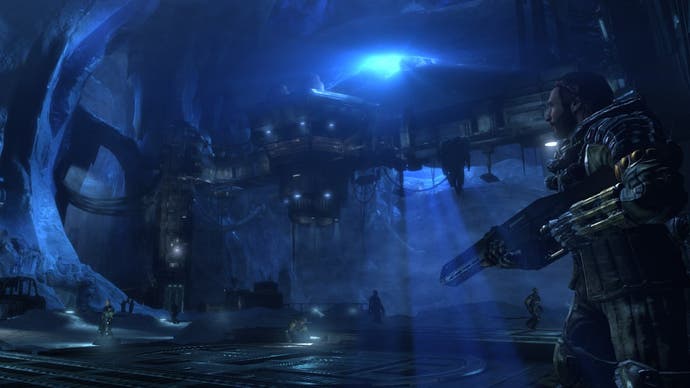
Other areas display a more explicit debt to Dead Space. Through the course of his missions, Jim uncovers several deserted installations - a mystery made more mysterious by the fact that his crew were supposed to be the first to settle on this strange new planet. Exploring them sees the introduction of overt horror elements to the Lost Planet series - quiet moments are punctuated with the screech of metal, while the installation itself is empty squalor lit with pulsing blue neon. The feeling of familiarity is underlined when Jim pulls out his inventory, projected in the in-game world via a dim hologram.
To its credit, Spark brings much more to Lost Planet than a handful of borrowed ideas. It's at its strongest when dealing with larger enemies, and when it's tying together the first-person mech combat with the third-person shooting. A hulking crustacean squares up to the mech for a toe-to-claw fight, setting off a bout of hydraulics-assisted fisticuffs. To defeat the boss, it's necessary to grab one of its pincers before bounding out of the mech and taking potshots at its exposed weak-point with a shotgun.
Giant enemy crabs with glowing orange weak spots might not sound like the most exciting of concepts in a game that's born in the embers of this generation, but it's a concept that's true to the spirit of Lost Planet, and indeed true to the spirit of Capcom. Lost Planet 3's an intriguing-looking addition to the series, and strong enough that come its release, the story shouldn't be about the choice of developer, but rather a project that's been able to weather the storm.
